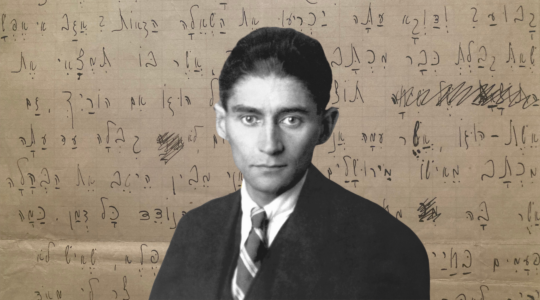Let’s get the controversy out of the way immediately: Anyone who finds Julian Schnabel’s new film “Miral” to be any more pro-Palestinian or anti-Israeli than dozens of other recent films about Israel’s policies in the West Bank hasn’t been getting out much.
The film definitely presents the Israeli presence in Gaza and the West Bank as an occupation and an illegal one at that. It does include a scene in which a young Palestinian woman, the title character, is beaten by an Israeli prison guard. It does have a Palestinian character say that the settlers on the West Bank represent a danger to everyone else, especially to the Israeli soldiers who are sent to defend them.
These are unexceptional positions. There are elements within mainstream Israeli society that would tell you any and all of the above things. And there have been many Israeli films — made by Israeli Jews, mind you — that have argued strenuously against the occupation and for a Palestinian state.
Schnabel’s position is clearly that of a supporter of the two-state solution, of an opponent of the occupation and of a Jew who wants the Palestinian and Israeli activists to embrace one another. The film is dedicated to “those on both sides who still seek peace,” and the most sympathetic Jewish character in the film is played by his daughter Stella. In a film that spends a great deal of screen time affirming father-daughter affinity, that strikes me as a significant piece of casting.
The problem with “Miral,” more than alleged anti-Israeli bias, is that the film is simplistic, ponderous, disorganized and at a running time of nearly two hours, tedious.
The film’s action, rather foolishly, covers a timeframe from 1947 to 1993. The backdrop to Miral’s arrest is the first intifada; she’s in prison in 1987 for suspicion of knowing a PLO activist (her boyfriend). She’s only there for 24 hours, which in turn arouses the suspicion of her “friends” in the movement. (One of the few things the film gets right is the way that young revolutionary movements have of turning inward and destroying their own.) The film ends on the eve of the signing of the Oslo agreement.
Adapted by Rula Jebreal from her highly autobiographical novel, it tells in laborious chronology the story of the Dar Al-Tifel Institute, a home and school for Palestinian children, its founder Hind Husseini (Hiam Abbas, who is wasted in a part that seems to have been designed for Greer Garson), and the family history of one of her students, Miral (Freida Pinto).
Schnabel and Jebreal obviously felt it imperative to leave out nothing from Jebreal’s novel, with the result that the film is nearly 45 minutes old before we even meet Miral herself. There is an entire series of relationships involving Husseini, an American colonel (an amiable Willem Dafoe), the local Arab leadership and a young imam who will eventually be Miral’s father. If the purpose of this lengthy prelude is to establish the school’s centrality to Husseini’s vision of education as the road to Palestinian self-determination, the entire matter could be better dealt with in minutes; as depicted here, this ideal is barely paid lip service, and most of the action is irrelevant.
The film is overstuffed with elaborate plot and thematic elements. We are treated to the story of Miral’s mother Nadia (Yasmine Al Massri), who is sexually abused as an adolescent and ends up as an alcoholic; Nadia’s jailhouse encounter with Fatima (Ruba Bial), a nurse who is in prison for a failed terror bombing; and finally Fatima’s brother Jamal (Alexander Siddig), whom Miral will marry. There are hints dropped about Miral’s possible parentage that finally result in an ostensible surprise, but that revelation comes so late in the film that there is no time left to pursue it. It remains just one more loose end among many.
Julian Schnabel’s films thus far have focused intensely on men under extreme duress and how they respond with dignity to the pressures of heroine addition and sudden celebrity (“Basquiat”), political and sexual oppression (“Before Night Falls”) and severe physical disability (“The Diving Bell and the Butterfly”). His female characters have seemed almost an afterthought before now, and by splitting the narrative focus between Hind Husseini, Nadia and Miral, he undermines the audience’s identification with and understanding of all three women.
That problem is intensified by his visually scattershot approach, with shifts in point of view that are incongruent with the conventionally linear narrative. Many of Nadia’s scenes are shot in a hazy, penumbral style, with the edges of the frame rapidly shifting in and out of focus. The supposed purpose of this particular stylization is that this is the way that Miral remembers her mother who died when she was a child, but the scenes take place before Miral is born, and the only way that a viewer could possibly figure out this ham-handed symbolism is by reading the press notes to the film.
Moreover, Schnabel is wildly inconsistent in his use of this device anyway, making nonsense of the conceit. The wildly swinging camera movements that encircle Hind Husseini throughout the film’s first sequences make even less sense. Schnabel’s overly emphatic directorial choices repeatedly frustrate and attenuate his authorial intentions. “Miral” may be well-intended but the result is a 10-ton soufflé. n
“Miral,” directed by Julian Schnabel, opens Friday, March 25 at the Lincoln Plaza, Broadway and 62nd St., (212)757-2280 or www.lincolnplazacinema.com, and the Angelika Film Center, 18 W. Houston St., (212)995-2000 or www.angelikafilmcenter.com.
There will be a special screening of the film at the 92nd Street Y, Lexington Ave. and 92nd St., on March 31 at 8 p.m., to be followed by a discussion with Schnabel, Rula Jebreal and Rabbi Irwin Kula. For information, call (212)415-5500.
The New York Jewish Week brings you the stories behind the headlines, keeping you connected to Jewish life in New York. Help sustain the reporting you trust by donating today.




